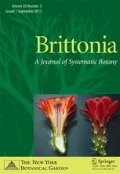Abstract
The genus Acalypha (Euphorbiaceae) contains three commonly cultivated ornamental species. Two of these have been propagated for centuries and are not known in the wild: Acalypha hispida and A. wilkesiana. A third species has only recently appeared in the horticultural trade, with the earliest evidence of its cultivation from the mid-1980s. This taxon is often grown in hanging baskets or as groundcover and owes its appeal to the possession of attractive, terminal pistillate inflorescences. Although it is commonly misidentified as A. hispaniolae, A. pendula, A. reptans, or A. repens, we present evidence that it is instead A. herzogiana, a native of Argentina, Bolivia, and Paraguay. Careful examination of the cultivated plants reveals that they differ from plants in the wild by possessing dimorphic pistillate inflorescences, a feature otherwise unknown in Acalypha. One of these inflorescence types is relatively inconspicuous and presents the typical structure of the majority of Acalypha in that the pistillate flowers are closely enveloped by an accrescent, foliaceous bract and not densely clustered. By contrast, the other inflorescence type is showy and highly anomalous. It consists of hundreds of densely clustered, ebracteate, abortive pistillate flowers. These unusual pistillate flowers are born in glomerules like the staminate flower and have no ovaries, but instead produce five to eight styles that arise directly from the receptacle in the position normally occupied by stamens in staminate flowers. We conclude that these unusual flowers are homologous to the staminate flowers of the wild plants and are the result of a homeotic mutation. Furthermore, we consider it unlikely that the homeotic mutation resulting in the development of the anomalous, showy pistillate inflorescences occurred in cultivation because without such inflorescences the plants would be non-descript and of little horticultural interest. The plant is a worthy subject for future research on hometic mutations, floral development, and gene expression.


Similar content being viewed by others
Literature Cited
Burman, N. L. 1768. Flora Indica. Cornelius Haak, Leiden.
Fosberg, F. R. 1980. Acalypha, pp. 7–12 in F.R. Fosberg and M.-H. Sachet. Systematic studies of Micronesian Plants. Smithsonian Contributions to Botany 45: 1–40.
Govaerts, R., D. G. Frodin & A. Radcliffe-Smith. 2000. World checklist and bibliography of the Euphorbiaceae (with Pandaceae). World Checklists and Bibliographies 4, Royal Botanic Gardens, Kew. 1621 pp.
Herwig, R. 1987. Growing beautiful houseplants. Facts on File, New York. 384 pp.
Hodgson, L. 1989. Houseplant futures: assessing the new crop of indoor plants. Horticulture 67: 44–47.
Lorenzi, H. & H. Moreira de Souza. 2001. Plantas ornamentais no Brasil: arbustivas, herbáceas e trepadeiras. 3rd ed. Instituto Plantarum de Estudos de Flora: Nova Odessa, Sao Paulo.
Lourteig, A. & C. A. O’Donell. 1942. Acalypheae Argentinae. Lilloa 8: 273–333.
Müller, J. 1866. Euphorbiaceae, A. P. de Candolle (ed.), Prodromus systematis naturalis regni vegetabilis 15(2): 189–1261. Masson, Paris.
Pax, F. & K. Hoffmann. 1924. Acalypha, In: A. Engler (ed.), Das Pflanzenreich, IV 147. XVI. Heft 85 (Euphorbiaceae-Crotonoideae-Acalypheae-Acalyphinae): 12–177.
Radcliffe-Smith, A. 2001. Genera Euphorbiacearum. Royal Botanic Gardens, Kew. 455 pp.
The Royal Horticultural Society Horticultural Database. http://www.rhs.org.uk/ Accessed 27 May 2008.
Sagun, V. G., G. A. Levin & P. C. van Welzen. 2010. Revision and phylogeny of Acalypha (Euphorbiaceae) in Malesia. Blumea 55: 21–60.
Svenson, S. E. 1993. Shading and pot color influence growth and flowering of strawberry firetails. Proceedings of the Florida State Horticultural Society 106: 286–288.
Sloane, H. 1707. A voyage to the islands Madera, Barbados, Nieves, S. Christophers and Jamaica. Published by Hans Sloane, M.D. London. 264 pp.
Swartz, O. 1788. Nova Genera Species Plantarum seu Prodromus Descriptionum Vegetabilium maximam Partem incognitorum quae sub Itinere in Indiam occidentalem Annis 1783-87 digressit Olof Swartz. Stockholm, Uppsala and Abo. 157 pp.
Acknowledgments
We thank José María Cardiel and Kenneth J. Wurdack for reviewing the manuscript and providing many useful comments. This work was supported by United States Science Foundation grant (DEB-0128872) to Geoffrey A. Levin and Victor W. Steinmann. Karina Grajales-Tam assisted with the preparation of the figures.
Author information
Authors and Affiliations
Corresponding author
Rights and permissions
About this article
Cite this article
Steinmann, V.W., Levin, G.A. Acalypha herzogiana (Euphorbiaceae), the correct name for an intriguing and commonly cultivated species. Brittonia 63, 500–504 (2011). https://doi.org/10.1007/s12228-011-9181-5
Published:
Issue Date:
DOI: https://doi.org/10.1007/s12228-011-9181-5




